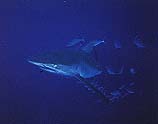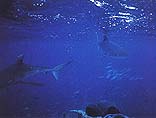Text and pictures by Jeremy Stafford-Deitsch
There has been a general trend, over the last decade or so, for divers to grow increasingly over-confident when encountering sharks. Indeed, as more and more divers feed various species of reef shark on tropical reefs, with only the rarest of mishaps, a cavalier tendency has slowly, but imperceptibly gained ground: because some species of shark can, under certain conditions, be relatively safely encountered, there is a growing assumption that many, if not all sharks can be approached/fed/photographed underwater without risk. However the only way to learn what can and cannot be done is trial and error - and error, when dealing with sharks, can lead to disastrous results.
 An example of a shark that is occasionally encountered on off-shore tropical coral reefs and is the subject of this salutary tale is the silky shark Carcharhinus falciformis. The silky is fairly easy to identify underwater: it is a relatively thin-bodied shark with no conspicuous fin markings. The head, when viewed from the side, comes to a sharp point. The first dorsal fin, located well behind the pectoral fins, tilts backwards and rises to a rounded apex. The silky - so-named for the smoothness of its skin (thanks to the small dermal denticle therein) is an open-water shark that more typically dwells in deep water well away from shore or reef. The impression one gets on seeing a silky shark is that of effortless manoeuvrability and stunning speed. But danger? Not especially. The king of tropical open water sharks is considered to be the oceanic whitetip Carcharhinus longimanus. This heavily-built, blunt-headed thug is thought to be far more dangerous than the elegant silky. Perhaps it is. Perhaps if it had been oceanic whitetips that I had been attempting to photograph on that fateful late-afternoon I would not be writing this article now.
An example of a shark that is occasionally encountered on off-shore tropical coral reefs and is the subject of this salutary tale is the silky shark Carcharhinus falciformis. The silky is fairly easy to identify underwater: it is a relatively thin-bodied shark with no conspicuous fin markings. The head, when viewed from the side, comes to a sharp point. The first dorsal fin, located well behind the pectoral fins, tilts backwards and rises to a rounded apex. The silky - so-named for the smoothness of its skin (thanks to the small dermal denticle therein) is an open-water shark that more typically dwells in deep water well away from shore or reef. The impression one gets on seeing a silky shark is that of effortless manoeuvrability and stunning speed. But danger? Not especially. The king of tropical open water sharks is considered to be the oceanic whitetip Carcharhinus longimanus. This heavily-built, blunt-headed thug is thought to be far more dangerous than the elegant silky. Perhaps it is. Perhaps if it had been oceanic whitetips that I had been attempting to photograph on that fateful late-afternoon I would not be writing this article now.
 I have encountered silky sharks on a few occasions in the past. On offshore coral reefs an occasional silky might swim up for a close approach, perhaps a very close approach, and then glide into the background, never quite disappearing, never coming in quite as close again. Silkies I have met in open water have been generally well-behaved: more than impressive to look at, but not all that aggressive. I was shown a video a diver shot on a night dive in the Red Sea in which a silky did indeed make several aggressive approaches. I presumed this was either because the diver had rolled into the water on top of the shark and startled it, or because the shark was feeding at the time. Nevertheless, apart from this one exception, I did not think that the silky should be placed particularly high on the list when it comes to dangerous sharks. After all, so the old theory goes, some sharks - like the oceanic whitetip, the bull shark, the tiger shark and the great white - have teeth designed to bite chunks out of large prey while other sharks - including the silky - are better adapted to catch smaller fishes that they can swallow whole. It is therefore thought to be unlikely that they would attempt to tackle anything large.
I have encountered silky sharks on a few occasions in the past. On offshore coral reefs an occasional silky might swim up for a close approach, perhaps a very close approach, and then glide into the background, never quite disappearing, never coming in quite as close again. Silkies I have met in open water have been generally well-behaved: more than impressive to look at, but not all that aggressive. I was shown a video a diver shot on a night dive in the Red Sea in which a silky did indeed make several aggressive approaches. I presumed this was either because the diver had rolled into the water on top of the shark and startled it, or because the shark was feeding at the time. Nevertheless, apart from this one exception, I did not think that the silky should be placed particularly high on the list when it comes to dangerous sharks. After all, so the old theory goes, some sharks - like the oceanic whitetip, the bull shark, the tiger shark and the great white - have teeth designed to bite chunks out of large prey while other sharks - including the silky - are better adapted to catch smaller fishes that they can swallow whole. It is therefore thought to be unlikely that they would attempt to tackle anything large.
Last summer Sha'ab Rumi reef in the Sudanese Red Sea was virtually cleaned out of sharks by unauthorised fishing. This summer, thankfully, the grey reef sharks have returned in force. But so, curiously, have a number of silky sharks. A French film crew had filmed them the week before we arrived and the divers on the previous Poseidon's Quest charter had reported several large silky sharks appearing off the end of the reef late in the afternoon. The silkies had approached closely and been photographed but had not appeared threatening to the divers.
 We arrived at the reef in mid afternoon and did our dive. No silkies appeared. But then, at the very end of the dive, as everyone was preparing to clamber into the RIBs, the silkies arrived, their supple bronze forms weaving fearlessly between the divers in the gloomy late afternoon light. There was a small shark of perhaps 5 ft in length, another of 6 ft, another long thin one of about 7 ft and finally a big, heavily built old warrior of 8 ft or more. The largest of the sharks would sweep up towards the surface to investigate the divers and as it did so all the rainbow runners in the vicinity would swarm around the great beating tail of the shark: perhaps they were none too fond of this big old silky and were massing around its tail for safety: it could not get to them there. Curiously though, some of the rainbow runners would rub themselves against the hide of the shark. This strange behaviour has been observed before and another explanation might be that the rainbow runners use the hide of the largest, least manoeuvrable, shark to dislodge parasites from their bodies. Whatever the explanation, the other schools of fishes on the reef were clearly unnerved by the approach of this impressive predator: swarms of plankton-feeding fusiliers darted back and forth en masse and a dozen or so dog-tooth tuna, usually seen swimming in the loosest of groups, swam past the front of the coral wall densely packed together as if expecting trouble.
We arrived at the reef in mid afternoon and did our dive. No silkies appeared. But then, at the very end of the dive, as everyone was preparing to clamber into the RIBs, the silkies arrived, their supple bronze forms weaving fearlessly between the divers in the gloomy late afternoon light. There was a small shark of perhaps 5 ft in length, another of 6 ft, another long thin one of about 7 ft and finally a big, heavily built old warrior of 8 ft or more. The largest of the sharks would sweep up towards the surface to investigate the divers and as it did so all the rainbow runners in the vicinity would swarm around the great beating tail of the shark: perhaps they were none too fond of this big old silky and were massing around its tail for safety: it could not get to them there. Curiously though, some of the rainbow runners would rub themselves against the hide of the shark. This strange behaviour has been observed before and another explanation might be that the rainbow runners use the hide of the largest, least manoeuvrable, shark to dislodge parasites from their bodies. Whatever the explanation, the other schools of fishes on the reef were clearly unnerved by the approach of this impressive predator: swarms of plankton-feeding fusiliers darted back and forth en masse and a dozen or so dog-tooth tuna, usually seen swimming in the loosest of groups, swam past the front of the coral wall densely packed together as if expecting trouble.
 I desperately wanted to photograph them and felt there was no time like the present. Grabbing my Nikonos and 15mm lens, I asked to be taken back to the point. I expected the sharks to come in close as they had done before, and I instructed Tony, the RIB operator, to stay nearby just in case I had to make a rapid exit.
I desperately wanted to photograph them and felt there was no time like the present. Grabbing my Nikonos and 15mm lens, I asked to be taken back to the point. I expected the sharks to come in close as they had done before, and I instructed Tony, the RIB operator, to stay nearby just in case I had to make a rapid exit.
As we reached the point a group of bottlenose dolphins swam around the inflatable. Fitting on my mask I mused to myself that I was breaking several of my own safety rules. I was swimming with sharks when there were dolphins present - the sharks can mistake you for an injured dolphin. I was swimming with large, open-water sharks on my own (no one had volunteered to come with me!) and I was swimming with sharks as dusk approached - and many species of shark are crepuscular in their feeding habits. But then the silkies might be gone tomorrow and anyway I could always jump back in the RIB if things got out of hand.
 As I slipped into the gloomy water at the edge of the reef the smallest silky swooped past me. I was taken aback at its new-found pace. But then it was only an over-excited youngster. I looked below into the gloom and gulped. The two largest sharks were powering up from below towards me at the same alarmingly rapid pace. My instincts shrieked danger. At the last moment they stopped right in front of me. I nervously took a blurred shot as I tried to convince myself that they would calm down, circle, return to the gloom and circle again. But they didn't retreat an inch. Instead their heads were sweeping from side to side as they worried their way ever closer. I decided I needed to gain some respect and kicked the bigger one in the head with my fin. It shuddered, spun in an angry circle and immediately returned to its original position hovering inches from my fins, twitching and trembling in a mass of nervous energy. I kicked it again and it did not even bother to react. I kicked the second shark with my other fin and it was similarly unimpressed. I could hear the engine of the inflatable and judged it to be twenty or thirty metres away. I waved my free arm in the air, hoping Tony would recognise my alarm signal and race over to me. The sharks hovered, shuddered and twitched, working their way towards me, forcing me to back-pedal. I swam towards the reef crest, planning to swim onto the top of the reef - where the water is about a metre and a half deep, and signal and yell to be collected. The sharks would surely not follow. But follow they did, each positioned immediately behind a fin. I swam on my back so that I could keep an eye on both sharks and, out of some deep sense of fatalistic obstinacy, fired off a few frantic shots as I retreated over the top of the reef. Now I was 5m from the reef crest, now 10m, and the sharks were glued to me, contemptuously ignoring my repeated kicks to their snouts. Disaster was surely only seconds away. My only hope was to get back to the RIB: the further I was driven over the shallow top of the reef, the further I was from safety and yet if I stopped retreating the only thing left for the sharks to do was bite: at least if I kept swimming they would have to swim with me. I felt I was being tested: they were trying to find out what I could do to protect myself, what elaborate defences I had evolved from millions of years of life in the sea. Would I suddenly forge off into the distance with a spectacular burst of speed? Was I covered in venomous razor-sharp spines that would pierce their throats? Surely I had more to offer than a few pathetic kicks with my fins? They had called my bluff and were discovering my defencelessness. Although I knew I must get back to the RIB, fast, I was being forced to retreat ever further from safety. Swimming on my back, waving my free arm in the air, I hoped against hope that Tony in the RIB would see my call for help. I did not dare take my eyes off the sharks to see where the RIB was: they were too close, too poised, too likely to switch from aggressive investigation to outright attack. I instantly dismissed the idea of drawing my knife and using it as a weapon as a childish fantasy and anyway that would mean having to put my arm down to my leg and at least at present the sharks seemed mesmerised by my beating fins. If they were going to chew on anything let it be my fins.
As I slipped into the gloomy water at the edge of the reef the smallest silky swooped past me. I was taken aback at its new-found pace. But then it was only an over-excited youngster. I looked below into the gloom and gulped. The two largest sharks were powering up from below towards me at the same alarmingly rapid pace. My instincts shrieked danger. At the last moment they stopped right in front of me. I nervously took a blurred shot as I tried to convince myself that they would calm down, circle, return to the gloom and circle again. But they didn't retreat an inch. Instead their heads were sweeping from side to side as they worried their way ever closer. I decided I needed to gain some respect and kicked the bigger one in the head with my fin. It shuddered, spun in an angry circle and immediately returned to its original position hovering inches from my fins, twitching and trembling in a mass of nervous energy. I kicked it again and it did not even bother to react. I kicked the second shark with my other fin and it was similarly unimpressed. I could hear the engine of the inflatable and judged it to be twenty or thirty metres away. I waved my free arm in the air, hoping Tony would recognise my alarm signal and race over to me. The sharks hovered, shuddered and twitched, working their way towards me, forcing me to back-pedal. I swam towards the reef crest, planning to swim onto the top of the reef - where the water is about a metre and a half deep, and signal and yell to be collected. The sharks would surely not follow. But follow they did, each positioned immediately behind a fin. I swam on my back so that I could keep an eye on both sharks and, out of some deep sense of fatalistic obstinacy, fired off a few frantic shots as I retreated over the top of the reef. Now I was 5m from the reef crest, now 10m, and the sharks were glued to me, contemptuously ignoring my repeated kicks to their snouts. Disaster was surely only seconds away. My only hope was to get back to the RIB: the further I was driven over the shallow top of the reef, the further I was from safety and yet if I stopped retreating the only thing left for the sharks to do was bite: at least if I kept swimming they would have to swim with me. I felt I was being tested: they were trying to find out what I could do to protect myself, what elaborate defences I had evolved from millions of years of life in the sea. Would I suddenly forge off into the distance with a spectacular burst of speed? Was I covered in venomous razor-sharp spines that would pierce their throats? Surely I had more to offer than a few pathetic kicks with my fins? They had called my bluff and were discovering my defencelessness. Although I knew I must get back to the RIB, fast, I was being forced to retreat ever further from safety. Swimming on my back, waving my free arm in the air, I hoped against hope that Tony in the RIB would see my call for help. I did not dare take my eyes off the sharks to see where the RIB was: they were too close, too poised, too likely to switch from aggressive investigation to outright attack. I instantly dismissed the idea of drawing my knife and using it as a weapon as a childish fantasy and anyway that would mean having to put my arm down to my leg and at least at present the sharks seemed mesmerised by my beating fins. If they were going to chew on anything let it be my fins.
 Then the larger shark surged past my left fin and was effortlessly alongside, fearlessly watching me with its yellow eye. I clunked the shark on the snout with the butt of my Nikonos. It ignored this puny blow and continued to glide parallel, watching, wondering at how easily it had penetrated my defences. I was finished. One blur of the broad head and the inevitable would happen. The repertoire of possibilities had been exhausted.
Then the larger shark surged past my left fin and was effortlessly alongside, fearlessly watching me with its yellow eye. I clunked the shark on the snout with the butt of my Nikonos. It ignored this puny blow and continued to glide parallel, watching, wondering at how easily it had penetrated my defences. I was finished. One blur of the broad head and the inevitable would happen. The repertoire of possibilities had been exhausted.
Then I heard the roar of the inflatable as it sped up to the side of the reef. The sharks, distracted, retreated a little. It was the first moment of doubt, of distraction, of hesitation that had registered in the silkies since I had re-entered the water. That moment's hesitation saved me: the noisy arrival of the inflatable had broken the pitiless, prehistoric spell that bonds hunter to hunted. The sharks backed off enough to allow me to turn and swim for the boat.
What lessons did I learn? What lessons should others learn from this? Our ignorance about sharks and their behaviour in the wild is all but total. I had glimpsed how rapidly the rules can change, how irrelevant everything I thought I knew could instantly become. Most sharks are not dangerous most of the time. But dusk is a special time. And I only just got away with it on this occasion - more sober, more respectful, more daunted than before. And with more grey hairs.
Web Links | Subjects | Search
Arabian Wildlife. Volume 2, Number 3